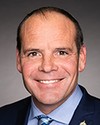I call the meeting to order.
Welcome to meeting number three of the House of Commons Standing Committee on International Trade.
The Board of Internal Economy requires that committees adhere to the following health protocols, which are in effect until February 28, 2022. Anyone with symptoms should participate by Zoom and not attend the meeting in person. Masks must be worn in committee rooms, except when members are at their place during parliamentary proceedings. However, it is strongly recommended that members wear a mask even when they are at their place during parliamentary proceedings. All those inside the committee room should follow best practices of maintaining a physical distance of at least two metres from others and maintaining proper hand hygiene by using the hand sanitizer provided in the committee room and regularly washing their hands well with soap.
As the chair, I will enforce these measures, and I thank you very much for your consideration.
Today's meeting is taking place in a hybrid format pursuant to the House order of November 24, 2021.
I'd like to outline a few rules to follow.
Interpretation services are available. You may speak in the official language of your choice. At the bottom of your screen, you have the choice of either the floor, English or French. If interpretation is lost, please inform me immediately and we will ensure interpretation is properly restored before resuming the proceedings. The “raise hand” feature is on the main toolbar, should you wish to speak. When speaking, please speak slowly and clearly. When you're not speaking, your microphone should be on mute. As a reminder, all comments should be addressed through the chair.
The committee clerk and I will maintain a speakers list, of course, for all of the members.
We are commencing a study on the Canada–United States relationship and its impacts on the electric vehicle, softwood lumber and other sectors.
With us today by video conference are, from the Automotive Parts Manufacturers' Association, Gian Paolo Vescio, general counsel; from Canada's Building Trades Unions, Sean Strickland, executive director; from the Canadian Vehicle Manufacturers' Association, Brian Kingston, president and chief executive officer; from Electric Mobility Canada, Daniel Breton, president and chief executive officer; from Toyota Motor Manufacturing Canada Inc., Scott MacKenzie, senior national manager, external affairs; and from Unifor, Angelo DiCaro, director of research, and Shane Wark, assistant to the national president.
Welcome, all.
Up to five minutes will be given for opening remarks, after which we will proceed with rounds of questions.
Mr. Vescio, I now invite you to make your opening statement. Please make sure that you keep within five minutes, after which I will have to cut you off.
Mr. Vescio, the floor is yours. Go ahead, please.











